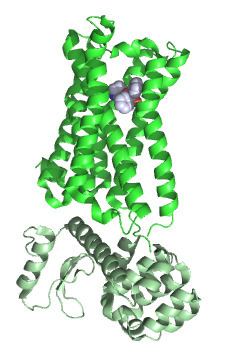Entrez 1129 | Ensembl ENSG00000181072 | |
 | ||
Aliases CHRM2, HM2, cholinergic receptor muscarinic 2 External IDs MGI: 88397 HomoloGene: 20190 GeneCards: CHRM2 | ||
The muscarinic acetylcholine receptor M2, also known as the cholinergic receptor, muscarinic 2, is a muscarinic acetylcholine receptor that in humans is encoded by the CHRM2 gene. Multiple alternatively spliced transcript variants have been described for this gene.
Contents
Heart
The M2 muscarinic receptors are located in the heart, where they act to slow the heart rate down to normal sinus rhythm after positive stimulatory actions of the parasympathetic nervous system, by slowing the speed of depolarization. They also reduce contractile forces of the atrial cardiac muscle, and reduce conduction velocity of the atrioventricular node (AV node). However, they have no effect on the contractile forces of the ventricular muscle.
IQ
A Dutch family study found that there is "a highly significant association" between the CHRM2 gene and intelligence as measured by the Wechsler Adult Intelligence Scale-Revised. A similar association was found independently in the Minnesota Twin and Family Study.
However, a larger 2009 study attempting to replicate this claim instead found no significant association between the CHRM2 gene and intelligence.
Olfactory behavior
Mediating olfactory guided behaviors (e.g. odor discrimination, aggression, mating).
Mechanism of action
M2 muscarinic receptors act via a Gi type receptor, which causes a decrease in cAMP in the cell, generally leading to inhibitory-type effects. They appear to serve as autoreceptors.
In addition, they modulate muscarinic potassium channels. In the heart, this contributes to a decreased heart rate. They do so by the G beta gamma subunit of the G protein coupled to M2. This part of the G protein can open K+ channels in the parasympathetic notches in the heart, which causes an outward current of potassium, which slows down the heart rate.
Ligands
Few highly selective M2 agonists are available at present, although there are several non-selective muscarinic agonists that stimulate M2, and a number of selective M2 antagonists are available.
